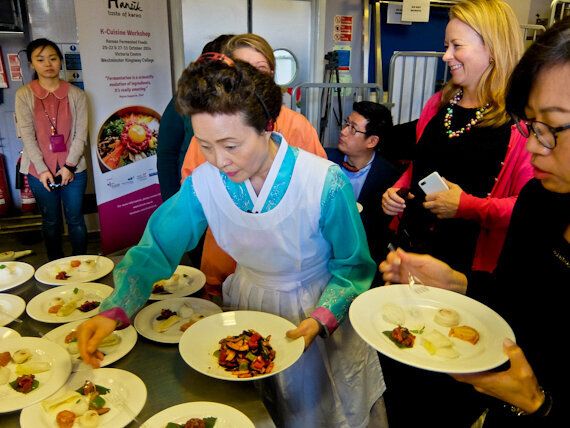Although it's usually made with cabbage, there are over 200 varieties of Kimchi in Korea, and fermentation produces lactic acid bacteria which protect against cancer, boost the body's immune system and keep your skin young.

I'm at Westminster Kingsway College, near Victoria station in London. for a Kimchi workshop given by Korean expert Sook-ja Yoon. The college has been running a 2 week course for budding Korean cooks, but I'm just getting a morning's worth of instruction to learn how to make 3 types of Kimchi. Now I'm fairly familiar with Korean food, having an excellent local restaurant, Dotori, at the end of my street, and I know that Kimchi is something of an acquired taste. It can be fiery, laced with chilli, and the fermentation process can sometimes deliver flavours, reminiscent of old smelly socks.

Today, however, all is Korean decorum and Sook-ja Yoon is dressed impeccably in clothes from the Royal court. She's a great advert for the country's food and first tells us that the colour of vegetables is linked to health - red is good for the heart, green good for the liver, important to eat when you have a hangover. Kimchi is low in sugar and fat and traditionally was used to provide vitamin C during winter when fresh vegetables were scarce. The bacteria produced during fermentation have been shown to fight colon cancer and stimulate the immune system. Surprisingly any pesticides on the vegetables disappear during the pickling process.

Cabbage Kimchi is the one we're most likely to encounter in Korean restaurants and Sook-ja Yoon demonstrates how to prepare it. You take a large Chinese cabbage and soak in salted water for 6 hours, also layering salt between the tough outer leaves. Meanwhile shred a white radish and mix it with Korean chilli powder which has been soaked in a mixture of salted shrimp and anchovy juice. Next add chopped watercress stalks, spring onions, mustard leaves and sliced fresh oysters, although you can also use squid or any type of seafood. The other essentials are minced garlic and ginger and then this mixture is kneaded together, adding salt to taste. Now we get our soaked cabbage and layer this mixture between the leaves, finally securing the bundle with the last leaf. Put the bundles into a jar and cover them with water from the empty bowl, and salt to taste.

Now the waiting begins. Traditionally the Kimchi was buried underground and fermented for up to 3 years, but these days every home has at least one Kimchi fridge, kept at a constant 10 degrees C. She tells me that you can keep your home made version in a normal fridge, but it must be stored in an air-tight container otherwise it will taint everything else. Fortunately she has some she made earlier and we get a taste. It's not as blisteringly spicy as others I've had, the flavourings more subtle. Sook-ja Yoon says that she has it with every meal, even breakfast, and she believes it's the secret for long life.

If you don't want to wait this long, she has another version made with aubergine, which is ready in a couple of days. The process is similar - vegetables are sliced and salted, then chopped red and green peppers are added, along with minced garlic and ginger and, of course, chilli powder, salt and a little sugar. Cover with brine, keep it in the fridge and it's ready to eat in 48 hours. Another variant uses broccoli and white radish to make watery Kimchi which you can eat straight away if you add a little white vinegar.

Of course there's a tasting at the end, Sook-ja Yoon delicately dispensing samples onto our plates. Each one has a different flavour, even though the basic ingredients, chilli, garlic, ginger and salt are the same. She tells us that, whilst she's been here, she's been adding the stuff to traditional English dishes - fresh Kimchi salad is a valuable addition to a fried breakfast, and fish and chips also benefits. I'm still thinking I'd like my Kimchi a little spicier so I suppose the only thing to do is go home and experiment. What I'd really like to do is taste it on its home turf - a trip to Korea seems to be beckoning. That's reinforced when I sit down to a delicious lunch with the ambassador, prepared by the students. They'll all be going out and spreading the word so it looks like Korean food will be coming to your local high street - it's just a matter of time.

The Korean Cultural Centre has information about all things Korea.

Korea Foods has information about ingredients and where to buy them in the UK.

All pictures copyright Rupert Parker.